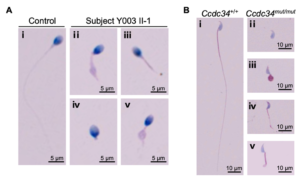Oligoasthenoteratozoospermia characterized by multiple morphological abnormalities of the flagella (MMAF) has been a major reproductive disorder with a highly genetically heterogeneous. Novel MMAF-associated genes remain to be identified in genetically unexplained MMAF cases. In this study, we identified homozygous deleterious CCDC34 variants that induce MMAF-associated oligoasthenoteratozoospermia in humans and mice. Also, treatment prognosis of intracytoplasmic sperm injection is good for MMAF patients and mice with CCDC34 deficiency. These findings will provide guidance for genetic counseling and insights into the diagnosis of MMAF-associated oligoasthenoteratozoospermia. (By Prof. Feng Zhang, https://jmg.bmj.com/content/early/2021/08/04/jmedgenet-2021-107919 )
Figure 1. Light microscopy analysis of spermatozoa from human (A) and adult male mice (B). Normal morphology of the spermatozoa from male control by H&E staining (i). The MMAF phenotype, such as absent, bent, irregular-caliber, and/or short flagella, were observed in the spermatozoa from harboring CCDC34 variants in human and mice (ii-v).
